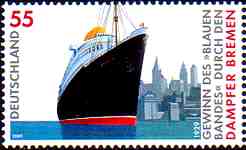
|
|
|---|
| |
Maritime Topics onStamps:
|
1858-Today: Six Passenger Ships called 'Bremen'
| |
75 years ago North German Lloyd’s (NGL) passenger liner ' Bremen ' won the symbolic Blue Riband for the fastest
Atlantic passage from east to west. On July 8, 2004, the German post office commemorated the event with the above stamp.
This 'Bremen' was already the fourth of five NGL vessels named after her home port. A sixth 'Bremen' was added to
the Hapag-Lloyd fleet in 1993, the successor to NGL, North German Lloyd having merged with Hapag in 1972.
|
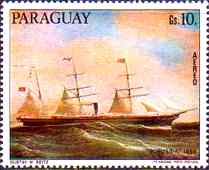
|
The specifications of Bremen (1)
- built at Caird & Co., Greenock, UK
- 2674 GRT, 2756 tdw
- ength 333 ft, width 39 ft
- compound engines, 1310 HP, 11 kn,
- three masts with auxiliary sails,
- Passengers: 60 I, 110 , 400 TwD.
- Crew 102
- launched Feb. 1, 1858
| |
June 19,1858 maiden voyage Bremerhaven - New York, arrival on July 4th,
thus travel duration 14 days and 13 hours. She was the NGL’s first overseas steamer.
In January 1859 she returned to Bremerhaven under sails with a broken tailshaft; six
months later she re-entered service with a new tailshaft. In June 1874, the first ' Bremen ' was sold to E. Bates & Co., Liverpool, and subsequently converted to a fullrigged sailing ship.
On October 16, 1882, wrecked on South Farralones, California.
| |
The Paraguayan stamp above shows the steamer 'Borussia'. The first 'Bremen' with one funnel, three masts, and auxiliary
sails looked almost exactly the same. There exists a postage meter of Bremen (1), see right.
|
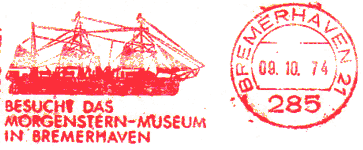
|
The specifications of Bremen (2)
- built by F. Schichau, Danzig,
- 10,522 GRT, 11,900 tdw
- length 525 ft, width 60.5 ft
- two Iquadruple expansion engines, 7,900 HP
- twin screws, 15.5 kn
- Passengers: 230 I, 250 II, 1850 Tweendeck
- Crew 250
- One of fouur sisters of the 'Barbarossa' class,
- Nov 14, 1896 launched, May 26, 1897 delivered.
|
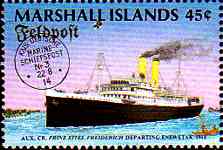
|
June 5, 1897 start of maiden voyage Bremerhaven - New York. First trip
Bremerhaven - Sydney on October 29, 1897.
On June 30,1900, the ship as well as two further Lloyd steamers suffered heavy
damage by the major fire of the Hoboken piers at New York; 300 humans died.
In October 1901, following repairs and conversion at the Stettin Vulcan yard, the
second 'Bremen' was on duty again by October of 1901.
Her specifications thereafter were 11,540 GRT, 570 feet length, and a
passenger capacity of 392 in first class, 273 in second, and 1682 in tween decks.
In August of 1914 she was laid up at Bremerhaven. From Oct. 9 to
Dec. 17,1918, serves as troop transport for the German Imperial Navy.
On April 4, 1919, delivered to The Shipping Controller, London; managed by P&O Lines.
In February 1921 sold to Byron SS CO, London, and renamed ' Constantinople ' .
1923 she was registered by the National S.N. Co., Panama, and renamed 'King Alexander'.
Scrapped 1929 at E. Breda, Venice.
The stamp shows the steamer 'Prinz Eitel Friedrich, another NGL vessel. 'Bremen' (2) with an almost identical appearance.
|
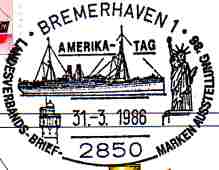
|
The specifications of Bremen (3)
-
built 1900 as ' Prinzess Irene ' by Vulcan AG, Stettin
- 1923 renamed ' Bremen ' (3)
- 1928 renamed ' Karlsruhe '
- 10,881 GRT, 10,600 tdw,
- Length 545 ft, width 61 ft
- two quadruple expansion engines, 8000 psi
- 2 screws, 16 kn,
- Passengers 268 I, 140 II, 1954 tweendeck (altogether 2,362)
- Crew 223
- Also belonged to the 'Barbarossa' class,
- June 19, 1900, launched, Sept. 6, 1900, delivered.
|
Sept. 9,1900, maiden voyage Bremerhaven - New York. Oct. 30,1900,
first trip Bremerhaven - Yokohama,
April 30,1903 first voyage Genoa - New York.
In April of 1904 rescued the crew of the Austrian schooner 'Marije'.
April 10, 1909 rescued 109 shipwrecked persons of the Cunard steamer
'Slavonia' which ran aground off the Azores.
On June 1910 the ship stranded off Long Island. She was salvaged and
repaired in Newport News, Virginia.
August 1914 laid up in New York due to outbreak of World War I.
1917 seized by the U. S. Navy and employed as roop transpor 'Pocahantas'.
1919 to U.S. Shipping Board, New York. 1920-21 trips to Europe under charter
to U.S. Mail S.S. CO.
In September 1922 re-purchased by NGL. Following reconstruction at Bremerhaven, the ship had 10,826 GRT with
a passenger capacity of 322 in first class and 508 in third, the tween deck accommodations were abolished!
April 7, 1923 first journey Bremerhaven - New York under her new name 'Bremen'.
Jan. 26,1926 rescued 6 men of the British freighter 'Laristan', which sank in a snowstorm the following day with 26 lives lost.
In 1928 she was renamed 'Karlsruhe', when the newest ' Bremen ' (4) was launched.
1931 first voyage in Bremerhaven - Cuba - Galveston service. Scrapped at Bremerhaven in 1932.
The pictured hand stamp cancel shows NGL’s steamer 'Preussen' , also built by the Vulcan shipyard. 'Bremen' (3) and 'Bremen' (2) were both part of the Barbarossa class and looked identical to the cancel shown above.
|
The specifications of Bremen (4)
-
- Turbine ship
- built at Deschimag, AG Weser, Bremen,
- 51,656 GRT, 14,565 tdw,
- L*B*T 939 * 102 * 32 ft
- 4 set of geared steam turbines, 130,000 PSw
- 4 screws, 26.5 kn, max. 29 kn
- Passengers 800 I, 500 II, 300 tourists, 617 III class
- Crew 1000
- catapult mail plane
- streamlined superstructures
- newly developed bulbuous bow
- Aug. 16,1928 launching
- July 5,1929 delivery
To the right you see North German Lloyd’s Launching Party invitation card,
lightly stamped 'launching Lloyd high-speed steamer Bremen at Deschimag Weser yard'.
|
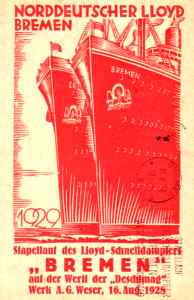
|
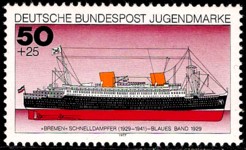
|
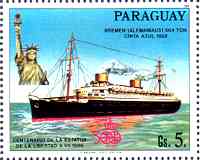
|
16th July of 1929: Start of maiden voyage Bremerhaven - New York, the passage which captured the Blue Riband with an average speed of 27.83 kn.
On her homebound voyage she achieved a new record with an average speed of 27.91 kn.
In June 1933 there was yet another record with 28,51 kn on the route Ambrose to Cherbourg.
Famous personalities such as Marlene Dietrich, Henry Ford, Max Schmeling, Fedor Schaljapin, an Indian Maharadja, and the American Ambassador patronize the 'Bremen' for their passages. Her jovial captain, Commodore Leopoold Ziegenbein, was esteemed by both crew and passengers alike.
By the mid-1930s Nazi Germany’s racist policies were also felt on 'Bremen'.
In 1934 the Jewish personnel were fired. In 1935 in New York, protesters ripped the swastika flag from Bremen's stern.
International travelers avoided the German ships. There even were some crossings from America to Europe with
only 15 to 30 paying passengers. Finally, the Nazi ‘crystal night’ of November 1938 led to the cancellation of a number
of voyages.
|
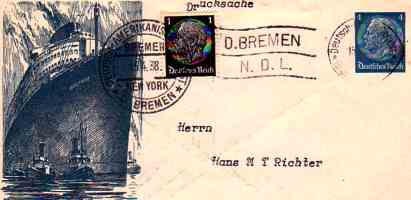
|
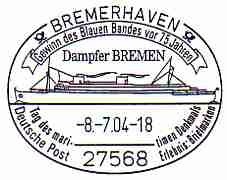
|
With the imminent outbreak of war, on August 30,1939 'Bremen' departed New York for Murmansk, without passengers and camouflaged by her crew.
On Oct. 10, 1939 she sailed from Murmansk breaking the British blockade for
Bremerhaven where she remained to the end of her days.
From 1940 onwards she served as an accomodation ship for the Navy. Also was contemplated to serve as troop
transport for the planned invasion of England.
From March 16-18, 1941, the 'Bremen' became a fiery inferno and a total loss due to arson set by a disgruntled
decksboy. She was scrapped in 1946. On April 1, 1946 last remainders of her double
bottom were dragged up the river Weser and set on the beach at Nordenhamm where they can still be seen today during extremely low tides.
Regarding the funnels: Those fashionably low funnels were lengthened later do accommodate passengers’
complaints about the soot on deck and on their chairs.
|
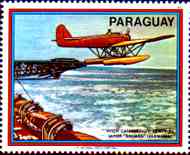
|
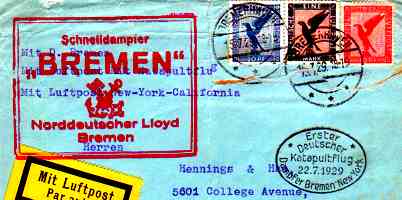
|
About the mail seaplane: one day prior to the ship’s arrival in New York or Cherbourg it took off by means of the catapult.
Thus the mail got there 14 hours earlier, which reduced the running time of the mail substantially. The airplane was a
Heinkel air boat, flew with 215 km/h and could carry 440 lbs of mail, i.e. about 11,000 covers.
The letter shows the handstamp applied aboard 'Erster Deutscher Katapultflug 22.7.1929'
(first German catapult flight July 22,1929). In 1931 'Katapultflug' was changed to 'Schleuderflug' (fling flight).
|
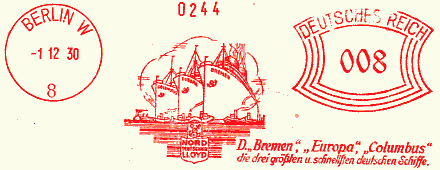
|
Up until WW II, Bremen (4) and her sister ship 'Europa' were Germany’s largest and fastest merchant vessels
maintaining NGL’s status among the world’s top group of passenger liner companies.
Together with the steamer 'Columbus', NGL offered weekly departures
from Europe to America and back, a feat the Cunarders could not duplicate.
|
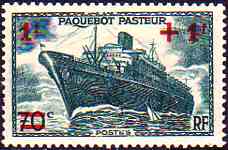
|
The specifications of Bremen (5)
-
built as ' Pasteur ' at Penhoet, Chantiers et studio de St. Nazaire SA,
pc. Nazaire
- 32,336 GRT, 8,700 tdw
- length 696 ft, width 90 ft
- 4 geared steam turbines, 60,000 PSw
- 4 screws, 23 kn,
- Passengers 216 I, 906 tourist class
- Crew 544
l
- aunched Feb. 15, 1938
|
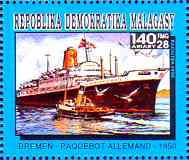
|
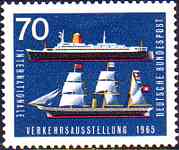
|
August 1939 delivery to the Cie de Nav. Sudatlantique, Bordeaux.
From September1940 until November 1946 service as a troop carrier, managed by Cunard White Star.
Nov. 4,1946 returned to Cie Sudatlantique,
Additional duty as a troop transport for war in Indochina.
July 1956 laid up at Brest.
August 19,1957 purchased by NGL. From January 1958 to July 1959 extensively rebuilt at the Vulkan dockyard at Bremen.
July 9,1959 first voyage Bremerhaven - New York. Jan. 15,1960 first cruise.
Sept. 1,1970 transferred to Hapag-Lloyd in merger Hapag and NGL.
January 1972 sold to Chandris Lines, Piraeus, and renamed 'Regina Magna'. Mediterranean cruises for the next two years.
Oct. 17, 1974 laid up at Piraeus.
Nov. 1,1977 at Djeddah as hotel ship 'Saudiphil 1' , 1980
renamed 'Filipinas Saudi 1'.
June 9, 1980 sunk in the Indian Ocean due to leaky sea valves while under tow for scrapping at Kaohsiung.
|
The specifications of Bremen (6)
-
built 1990 as ' Frontier Spirit ' at Mitsubishi Heavy Industries, Kobe
- 6752 BRZ, 1,226 tdw,
- L*B*T 366 * 59 * 15 ft
- 2 Daihatsu Diesel engines, 4,854 KW
- Speed of 17 kn,
- modern stabilizer system,
- three pitch propellers
- 184 passengers
- Crew 100
|
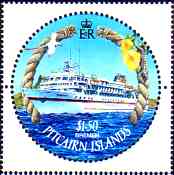
|
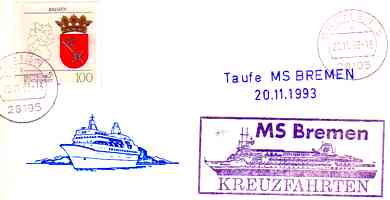
|
1990 commenced service for Frontier Cruises, Japan.
1993 bought by Hapag-Lloyd and renamed ' Bremen ' (see adjoining cover).
An upscale expedition ship for adventure cruises with destinations ranging from steamy tropic waters to icy polar outposts.
Still in Hapag-Lloyd service today (2004).
June 2005 the ship goes in charter of Expedition Leaders, USA, and will be renamed in 'Discoverer'.
|
|
With a range of 8,000 nautical miles, shallow draft, and highest ice class safety certificate this 'Bremen' is outstanding in many ways. She can visit the
smallest ports, and her Zodiacs provide for landing in the most remote regions.
Advertised by Hapag-Lloyd for ‘spirit of adventure and quest for exploration in relaxed surroundings’.
|
The 'Blue Riband of the North Atlantic’ was a famous -- although symbolic -- trophy without any officially issued rules.
The 'unwritten laws' were fully sufficient:
- The ship had to be a passenger liner.
- The crossing had to befrom east to west from Europe to North America.
- The ship with the highest averaged speed is the winnerI.
In 1935 the Englishman Harold K. Hales donated a cup called the 'North Atlantic Blue
Riband Challenge Trophy'.
|
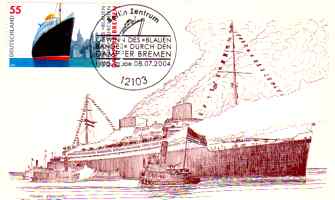
|
Sources:
‘Die Seeschiffe des Norddeutschen Lloyd’, by Arnold Kludas
Magazine ‘Schiffahrt International’, 1/94
NDR3-TV documentary 'the Bremen of 1999’.
|
© 1998 - 2004 Bjoern Moritz, all rights reserved.
|